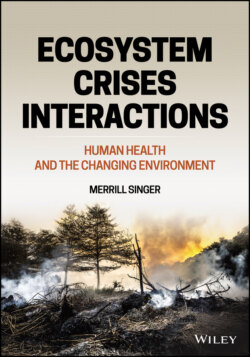Читать книгу Ecosystem Crises Interactions - Merrill Singer - Страница 26
1.12 Organization of this book
ОглавлениеThe following chapters lay out an environmental health approach to ecocrises interaction that is informed by anthropology, ecology, climate science, history, and political economy. This begins in Chapter 2 with a dive into the intricacies of planetary ecosystems and the rise of the field of ecological study. Under consideration is the nature of nature, specifically the interrelationships among species in an environmental context, as well as biodiversity and environmental regional and planet‐wide structures (e.g., air currents, hydraulics). Chapter 3 examines the social, economic, and technological bases of the contemporary environmental crisis, including the role played by the ongoing development of capitalism and the growth of a class of wealthy polluting elites, who represent the primary drivers of catastrophic environmental pollution. Chapter 4 provides an overview of the environment catastrophe unfolding during the Anthropocene, including the patterns of sweeping change reshaping life on the planet: pollution of the water, the air, and the land; habitat restructuring and ecological simplification; species movement; and species die‐offs and extinctions. Chapter 5 offers a specific investigation of the major environmental crises endangering Earth as our planetary home, including the manifold expressions of contemporary environmental disruption. Building on this background, Chapter 6 explores the nature and threat of ecocrises interaction and presents several case studies of the physical, chemical, and biological factors involved in these perilous processes. Chapter 7 addresses the mechanisms and pathways of adverse interaction. Chapter 8 provides a detailed examination of climate change as the primary driver of ecocrises interaction. To explicate our response to climate change and why it progresses despite growing awareness of the risks it is ushering in, Chapter 9 scrutinizes the growth of climate change denial and the offensive against environmental science generally. Chapter 10 looks at how we continue to cross vital thresholds and approach identified planetary boundaries for human life as we know it. Finally, Chapter 11 offers a consideration of how you can participate in seeking to avoid the worst perils we face based on a review of human movements for change and alternative models for a sustainable future.
